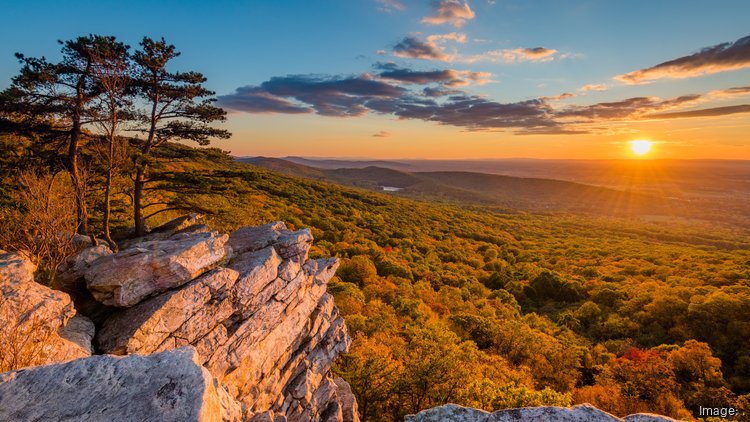
What comes to mind when you think of the forestry industry? Lumber yards? Or maybe swaths of land with stumps of cut-down trees? If this is the direction your mind goes, you’re not alone.
Unfortunately, many people are unaware of just how much of a positive impact the forestry sector has on the economy and ecosystem. This error was highlighted by Beth Hill, executive director of the Maryland Forests Association at the 2025 MEDA Annual Conference.
Contrary to popular belief, the logging industry is not depleting our forests. According to the University of Maryland Extension, the current rate of logging affects only 0.4% of all forests across the state. Those forests don’t go unreplenished; according to the organization, Maryland grows around 4.5 times the volume of wood harvested each year, equating to an overall growth across the state.
Rather than destruction and pollution, the industry supports the ecosystem, creating more opportunities for economic growth and the continued development of Maryland’s forests. And with more than 40% of the state covered by forests, this sustainability is pivotal.
During her presentation, Hill highlighted a common misconception – that every tree needs to remain standing for a healthy forest. In reality, there is much more work and knowledge that goes into sustaining and growing forests.
First and foremost, management is essential; through strategic planning and processes, the health of soil, trees and other natural resources are maintained. This management includes vegetation conservation and restoration, soil testing and more. With this continued maintenance comes significant economic growth.
Forestry’s economic advantages
Included under the umbrella of agriculture, forestry offers significant benefits and contributions to the economy.
In Southern Maryland alone, forestry businesses contribute more than $585 million to the state’s economy while simultaneously supporting over 3,000 jobs and driving regional economic growth.
“Forests provide much-needed employment and economic sustainability for our rural communities,” Shelby Watson-Hampton, Southern Maryland Agricultural Development Commission’s director, commented in this guide. “And here in Southern Maryland, we are very fortunate to have the Dr. James A. Forrest Career and Technology Center, which offers students a wide variety of career-specific programs in natural resources, including forestry.”
However, as the fifth-largest manufacturing industry in the state, forestry brings in around $3.3 billion and offers more than 18,000 jobs across rural and urban areas.
Innovations in forestry
On top of being an economic driver, the forestry sector is fraught with innovation. In fact, there is a company right here in Maryland that produces wood stronger than steel.
While it sounds like something from a sci-fi novel, the product – MettleWood – is actually being produced in a manufacturing facility in Frederick, Maryland. This enhanced wood is created by removing the lignin and compressing the remaining wood, resulting in a product that is described as “60% stronger than construction-grade steel, but 80% lighter,” providing society with a strong, eco-friendly and rust-free alternative for construction work.
The company behind this innovation, InventWood, was spun out of the University of Maryland, College Park (UMD). Today, the company has received a $20 million grant from a U.S. Department of Energy’s program, allowing the company to move into a new headquarters and continue manufacturing.
A second example of innovations found in the forestry sector was found in the University of Maryland laboratories as well. Through genetically modifying poplar trees, researchers have engineered wood with the potential for storing carbon for a longer time, supporting efforts to reduce emissions and tackle global warming and accelerated climate change.
According to a previous article, Yiping Qi, a professor in the Department of Plant Science and Landscape Architecture at UMD and one of the researchers on the project, the innovative approach “combines genetic engineering and wood engineering to sustainably sequester and store carbon in a resilient super wood form.” This process, according to Qi is crucial in the “fight against climate change.”

Looking forward
The positions offered across the industry not only contribute to the economy’s growth but also drive the return of native wildlife, a direct result of many years of dedicated work protecting and restoring Maryland’s forests.
As we look towards the future, it is essential that we keep progress in mind while looking for new ways to collaborate and ensure healthy forests across the state. A great example of this continued trajectory and collaboration can be seen in the Five Million Trees for Maryland initiative, which began in 2021 with the goal of planting an additional five million native trees across the state by 2031, with at least 500,000 of these trees planted in urban and underserved areas.
“A tree is like a diamond ring, in my opinion,” Gary Allen, president of the Maryland Forestry Foundation, explained in a webinar. “A good diamond has a lot of facets to it.” Similarly, so does a tree, as he explained; if you plant a tree for water quality, you get much more than that – you also get an improved air quality, improved habitat support and even the creation of more opportunities for economic development across the state.
Source: Baltimore Business Journal